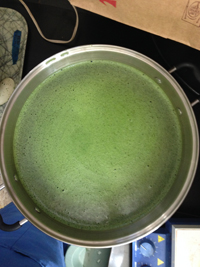The Acorn Chronicles
By Judith S. Musick
My adventures in acorn dyeing began with an attempt to do something productive with the thousands of acorns that fell around my house this Autumn—considerably more than had fallen in previous years. The question was what to do with this year's unexpected bounty, beyond merely raking it up and discarding it. The answer was to take advantage of it to create a warm brown dye for a tapestry I was weaving.
| Dye pot full of acorns | Extracted acorn dye stock |
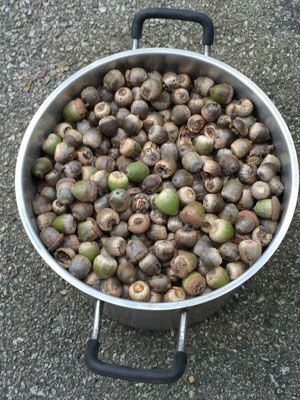 |
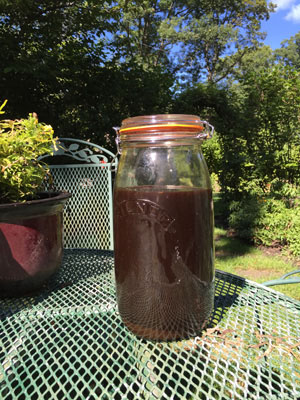 |
| Photograph Copyright by Judith S. Musick | Photograph Copyright by Judith S. Musick |
The initial step was to gather as many acorns as would fit in my large dye pot to get a sense of how many I was going to use. Looking at them, I decided (mistakenly, as it turned out) that it would be more expedient to crush them first, and set about trying to do so. It was a busy weekend, and I didn't want spend the time to crush them in many small batches, so I tried to crush them all at once, in a large sack. As it happened, at least for these particular, slightly damp acorns, there were simply too many, and thus, after several unsuccessful approaches, including hitting them with a hammer, smacking them with weights, etc., I decided to put them all in a large plastic garbage bag and run over them with my car. Of course, this would prove to be an absurd plan, although it seemed feasible at the time.
My son-in-law was at the house and, amused at this offbeat approach, offered to take pictures, in case I wanted to include this process as part of a "method" section. However, the car lifted up each time I drove back and forth over the bag; upon inspection, the acorns remained mostly intact. Finally, I abandoned this method, and just used them as they were to make the dye bath. In order to be able to add sufficient water for a dye bath, I first removed just the top few layers of acorns, and then slowly heated it to almost a boil. At this point, I lowered the dye bath to a simmer, and kept it there for an hour, let it cool, and strained it into a large glass jar. I discarded the used acorns in an empty part of my garden.
Next, I dyed 26.7 grams of pre-mordanted, medium natural white/cream-colored churro, keeping the pot at a low simmer for an hour and then letting the yarn cool in the dye bath. As I removed it, disappointment set in. The resulting color was, to me, an unattractive brown.
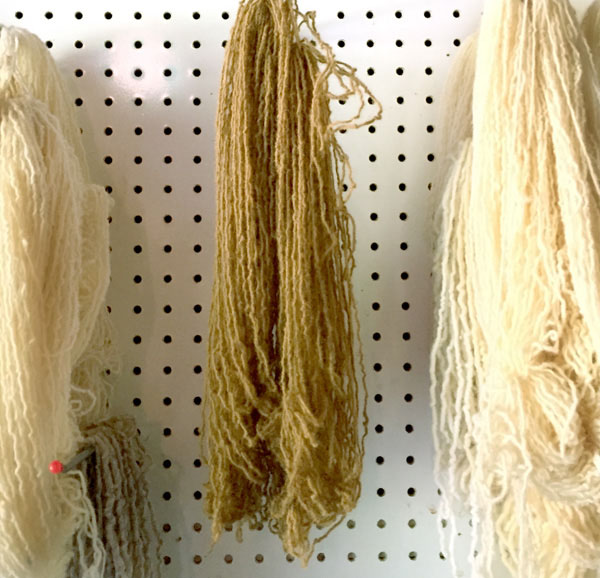
The iron I had ordered to deepen browns had not yet arrived, but the last thing I wanted was to "sadden" the color of this yarn. Before giving up however, I divided the dyed skein in half and made a dye bath with the last of the rudbeckia from my garden—some already dried and some still growing—an experiment to see if I could obtain a more khaki/olive color. In this way, I reasoned, yarn over-dyed with this "harvest" of acorns and black-eyed susans could represent Fall. Alas, rudbeckia did very little to change the color.
| Rudbeckia ready for dyeing | Acorn-dyed churro overdyed with Rudbeckia |
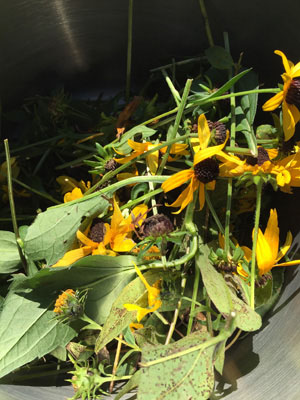 |
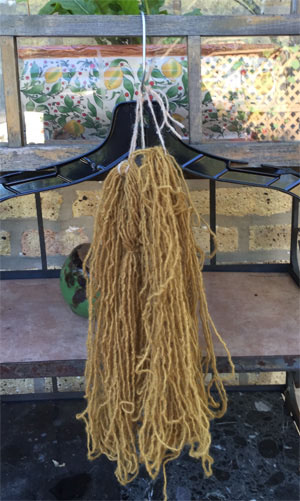 |
| Photograph Copyright by Judith S. Musick | Photograph Copyright by Judith S. Musick |
Now truly, I was ready to give up, but was persuaded to try once more by Pamela Feldman. At her suggestion, I over-dyed both skeins of yarn (with and without the rudbeckia) with cutch at a dark value, and behold, the result was a lovely, rich brown.
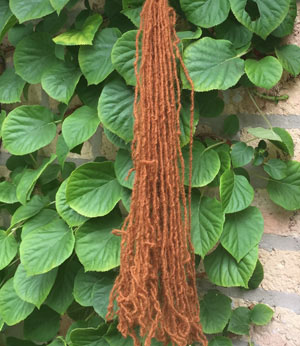
The higher strength of the cutch, versus that of black-eyed susans, yielded a clearer, more intense brown. Then, after I removed the two original skeins from the dye bath, I was able to use the dye that remained to transform several samples of yarn that I had dyed some time ago, but had found uninteresting. For, example, there was a faded green yarn, previously dyed with indigo and weld that was slowly turning blue/green. When over-dyed with the cutch, it became a darker, warmer green—a color found in the forests I have always loved.
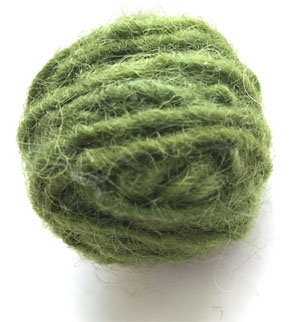
So (happily) ends this chronicle of a natural dyeing journey in which the wrong path taken, where one bends and sometimes even breaks the rules, can lead to beautiful results.
 Turkey Red Journal
Turkey Red Journal
